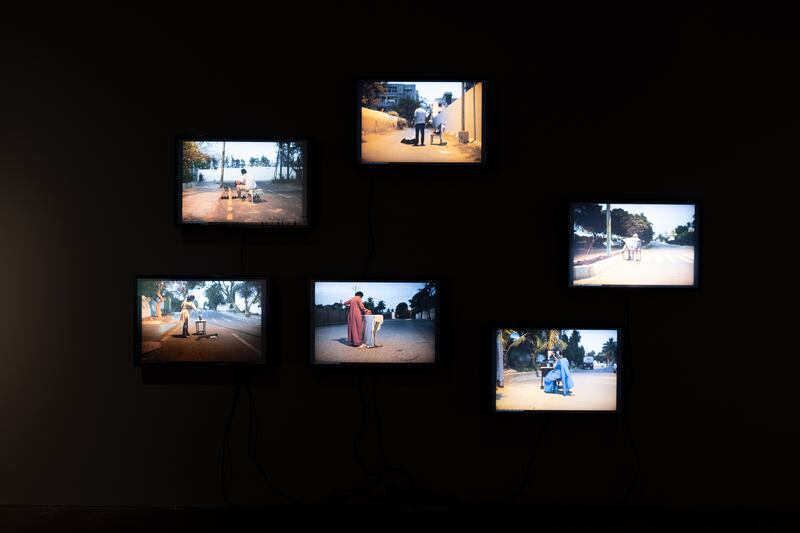Pakistani artist Bani Abidi, who lives in Berlin, has yet to travel to her largest US solo show to date, but she has already received surprising feedback for her work.
“I get messages on social media from the Latino community, who connect with the films I’m doing,” she tells The National, referring to her video work The Distance From Here (2009), about a visa application office in Islamabad. “There’s a lot of identity-based work in the US, but mine is more about politics and other forms of power. It represents the Global South in some ways.”
The video is on display as part of The Man Who Talked Until He Disappeared, a newly opened retrospective of Abidi's work at the Museum of Contemporary Art in Chicago. Alongside it is Security Barriers A-Z (2009-2019), a series of works on paper indexing security barriers in cities the artist has visited. Real steel barriers also appear in the gallery space, and intersecting queue lines have been painted on the floor.
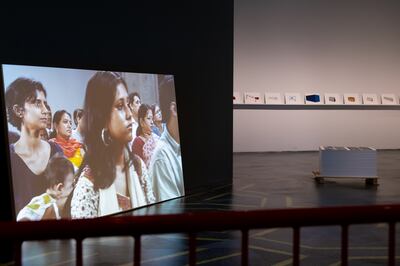
This retrospective at the MCA is the third in a series of solo presentations organised in collaboration with the Sharjah Art Foundation and led by its director, Sheikha Hoor Al Qasimi, and curator Natasha Ginwala, who lives in Berlin. Earlier stagings took place at the foundation and at the Gropius Bau, Berlin, in 2019.
This exhibition marks the debut of a new work by Abidi, The Reassuring Hand Gestures of Big Men, Small Men, All Men (2021). Seventy photographs, displayed as a collage, show hand gestures from tightly held fists, victory signs and salutes, to outward-facing palms. “It came from how political leaders were dealing with the pandemic. I was really struck by the instances of female leadership, especially New Zealand’s Prime Minister Jacinda Ardern, who was just the opposite of everyone else in her mannerisms and casualness,” says Abidi. “I started thinking about the whole performance and drama of power.”
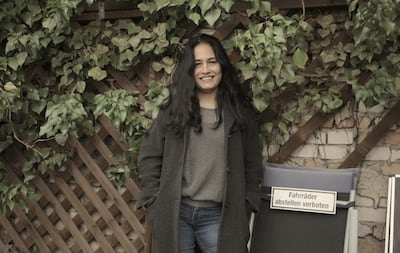
Abidi uses humour to comment on political culture, which, she says, is dominated by men. “Ridiculing power is an effective way of taking it down somehow. The only way that my work can be considered feminist is the way that I try to pull down and satirise gestures of power.”
Disembodied limbs are her main motifs of satire, and the process of indexing different hand gestures further undermines the performance. “When you index something, absurdity arises and it becomes banal because you have so much of it,” she says.
The focus on body parts appears in an earlier film, Death at a 30 Degree Angle (2012), which was originally commissioned by the Sharjah Art Foundation for the 13th documenta, the contemporary arts exhibition that takes place in Germany every five years. It tells the tragicomic fictional story of a local politician who commissions a sculpture of himself, but is dissatisfied with its various iterations. “He can’t decide if he should be portrayed as an intellectual, a warrior or a politician with a garland around his neck,” says Abidi.
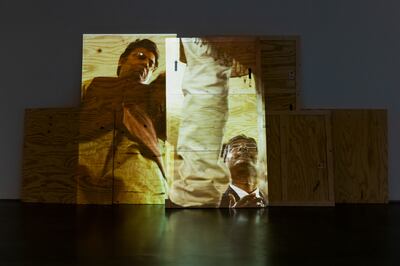
The work was inspired, in part, by the celebrated Indian politician Mayawati, a former schoolteacher of Dalit heritage, the religious caste considered “untouchable” by some Hindus, who rose to high ranking ministerial positions in the late 1990s and early 2000s. “She was obsessed with statues of herself,” says Abidi. But it also recalls the toppling of Saddam Hussein’s statue in 2003, and Abidi’s take on decaying Soviet architecture while travelling in Hungary.
Today, this video work takes on new meaning alongside the contemporary debates about sculpture and colonialism, which were sparked by the Black Lives Matter movement last year. “A larger question arises: do you live with colonial statues and let them decay, or do you remove them from memory,” she says.
“I am comfortable with colonial memory as a living memory, and constantly engaging with it and dealing with it in different ways,” she says. “In Karachi, many of the old colonial statues that I grew up with have been dumped behind buildings. The roads built and named by the British have been renamed.”
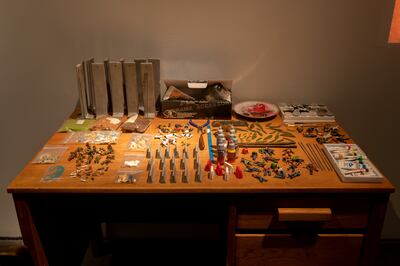
Abidi says her work is not meant to educate audiences about Pakistan. “It is about people, politics and history,” she says. “It is not a Pakistani voice, but a voice coming from Pakistan.”
Yet she continues to be compelled by the legacy of the Partition of India in South Asia. “For me, the nation state is this bogus problematic concept," she says.
Among her earlier work at the MCA is Mangoes (1999), which quips at manifestations of the India and Pakistan conflict in popular culture. “It’s the first work of mine that I totally loved,” she recalls. “I was living as a student in Chicago and it was the first time that I encountered Indians as close friends. I understood what diaspora nationalism was.”
In the video, an Indian and Pakistani woman from the diaspora, both played by Abidi, sit at the same table eating mangoes, and reminisce about mango season with their families back home. But the conversation turns sour when they start comparing the number of mango variations in each country.
In more recent work, Abidi explores the intangible traces of history and memory, those that were not immortalised into sculpture or mediatised by politicians.
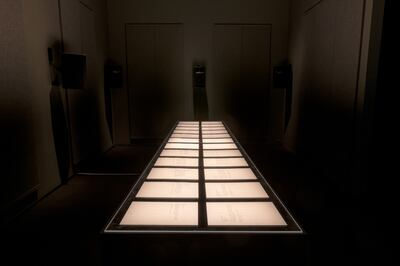
Her Memorial to Lost Words (2016) is based on the censored letters of Indian soldiers who fought with the British Army during the First World War, and the oral laments of the families they left behind. At the MCA, the letters appear alongside recordings of old songs performed by contemporary Punjabi folk musicians. It is one of many instances in which she has collaborated with such musicians and other practitioners to produce original pieces.
Beyond the exhibition, orality and nostalgia will appear in a coming work about diaspora and living in Berlin. “I’m developing a film about people singing themselves to home. Their different voices and tunes change the Berlin landscape,” she says.
This in part stems from the years she has spent living away from her native Karachi. “Displacement can be violent. I find it psychologically unsettling when I go to Karachi and it’s hot and humid, and then I return to a different climate in Berlin,“ she says. “Certain temperatures and smells trigger memories for me.”
But it also highlights the ever-changing voice of an artist who, 20 years into her career, refuses to be pinned down by routine or by place. “It’s a double-edged sword because, as an artist, I care about the locality, history and politics of where I am,” she says. “But I’ve become an outsider everywhere over time."
